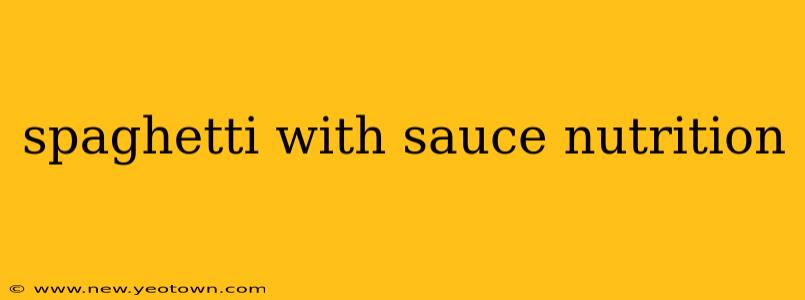Ah, spaghetti with sauce! The quintessential comfort food, a nostalgic trip back to childhood for many, and a weeknight staple for countless families. But beyond its deliciousness, what's really in a plate of this beloved dish? Let's unravel the nutritional details of this classic, exploring its potential benefits and drawbacks. We'll even tackle some common questions people have about its nutritional profile.
What are the nutritional benefits of spaghetti with sauce?
The nutritional profile of spaghetti with sauce can vary wildly depending on the ingredients. Are we talking whole wheat pasta? A simple tomato sauce? Or a creamy, meat-laden concoction? Let's consider a relatively healthy version: whole wheat spaghetti with a homemade tomato sauce.
In this scenario, you're getting a good dose of carbohydrates for energy from the pasta, along with fiber which aids digestion and keeps you feeling fuller for longer. A tomato-based sauce is rich in lycopene, a powerful antioxidant linked to reduced cancer risk and heart health. Tomatoes also contribute vitamins C and K, as well as potassium. If you add vegetables to your sauce – onions, garlic, peppers, mushrooms – you significantly boost the nutritional value, increasing the vitamin and mineral content.
However, it's crucial to remember that this is just one version. Added meats, cheeses, and creamy additions can drastically alter the nutritional landscape, often increasing fat and sodium content.
How many calories are in a serving of spaghetti with sauce?
This is another question where a simple answer is impossible. A single serving of spaghetti with a simple tomato sauce might clock in around 250-350 calories. However, the addition of meat (ground beef, meatballs), cheese, cream, or excessive amounts of olive oil can quickly push that number to 500 calories or more per serving. Portion control is key here, as is mindful ingredient selection.
Is spaghetti with sauce healthy?
The healthfulness of spaghetti with sauce is highly dependent on the ingredients and portion size. A plate of whole wheat spaghetti with a fresh, vegetable-rich tomato sauce can be part of a healthy diet. It provides carbohydrates, fiber, vitamins, and antioxidants. However, a heavily processed, creamy, and meat-laden version is far less healthy due to its high fat, sodium, and calorie content.
What are the ingredients in spaghetti with sauce?
This, again, depends on your recipe! The basic ingredients are spaghetti (typically made from semolina flour or whole wheat flour) and a sauce. The sauce itself could be anything from a simple tomato sauce (tomatoes, garlic, onion, herbs) to a more complex sauce with added meats, vegetables, cream, or cheese. The possibilities are nearly endless!
How much protein is in spaghetti with sauce?
The protein content is highly variable. Plain spaghetti provides a moderate amount of protein, but adding meat (especially lean meats like chicken or turkey) significantly increases the protein content. Beans or lentils in the sauce would also add to the protein profile. A vegetarian or vegan version will have less protein overall unless legumes or other protein-rich plant-based ingredients are included.
Is spaghetti with meat sauce high in sodium?
Yes, spaghetti with meat sauce can be quite high in sodium, especially if using pre-made sauces or processed meats. Many jarred sauces are packed with sodium, so checking the nutrition label is vital. Homemade sauces offer greater control over the sodium content, allowing you to adjust seasoning to your liking.
Conclusion:
Spaghetti with sauce is a versatile and customizable dish. By carefully selecting whole-grain pasta, using fresh ingredients, and paying attention to portion sizes, you can enjoy this comfort food while keeping it relatively healthy. But remember, moderation and awareness of ingredients are key to maintaining a balanced diet. Enjoy responsibly!

